Ige to face Tupola in general election race for governor





Jamm Aquino/ jaquino@staradvertiser.com
Supporters of governor David Ige react after the second printout at Ige’s campaign headquarters today in Honolulu.
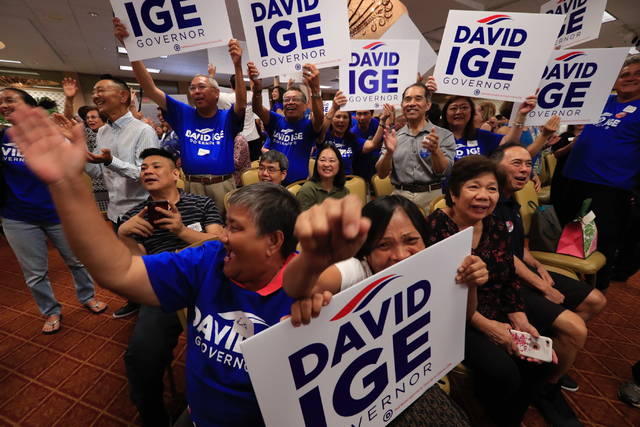
Jamm Aquino/ jaquino@staradvertiser.com
Supporters of governor David Ige react after the second printout at Ige’s campaign headquarters today in Honolulu.
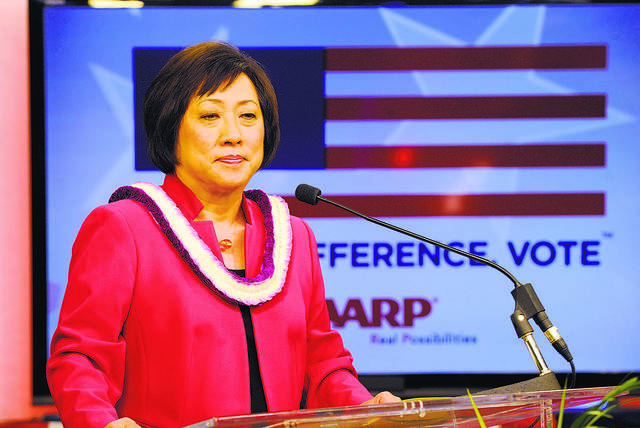
STAR-ADVERTISER FILE
Hawaii gubernatorial candidate U.S. Rep Colleen Hanabusa, shown here at a July 16 debate, has lost to incumbent Gov. David Ige for the Democrat nomination.
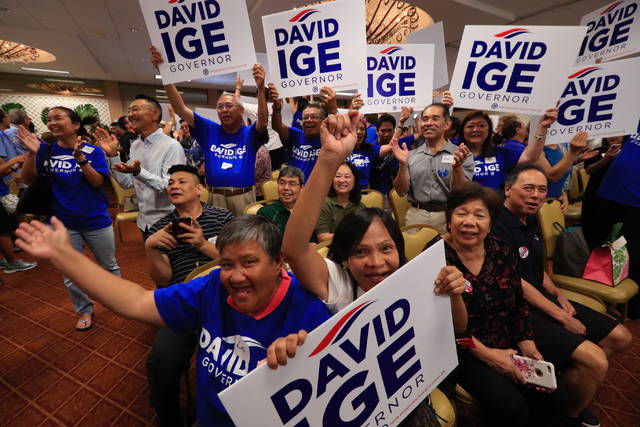
Jamm Aquino/ jaquino@staradvertiser.com
Supporters of governor David Ige react after the second printout at Ige’s campaign headquarters today in Honolulu.
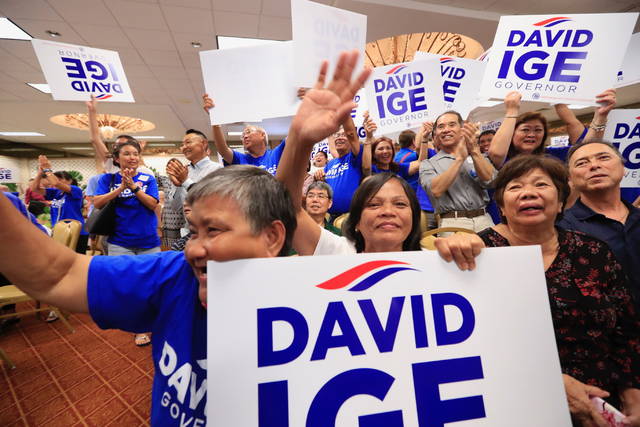
Jamm Aquino/ jaquino@staradvertiser.com
Supporters of governor David Ige react after the second printout at Ige’s campaign headquarters today in Honolulu.
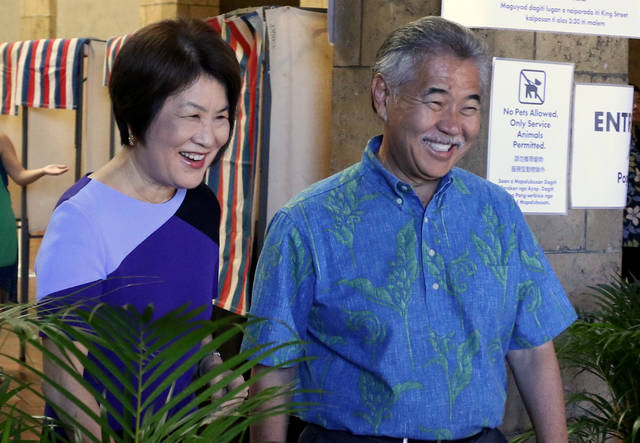
ASSOCIATED PRESS
Hawaii Gov. David Ige, right, and first lady Dawn Amano Ige smile after voting early Wednesday in the state’s primary election in Honolulu.










Gov. David Ige clinched victory over U.S. Rep. Colleen Hanabusa tonight after a bruising campaign that focused on leadership and trustworthiness. It was a dramatic turnaround for a governor whose re-election effort appeared to be in deep trouble just six months ago.
Hanabusa conceded in a speech shortly before 10:30 p.m. in which she praised and thanked her volunteers, and also the elected officials who supported her. She thanked her husband John F. Souza III for his support as well as U.S. Rep. Tulsi Gabbard, who endorsed Hanabusa in January.
She told a crowd of her supporters that “we gave people choices, and the people have spoken. So, I don’t want anyone to feel like you didn’t do enough, or you could have done more, because believe me, the one thing that I know, I know just by being out there, is that you volunteers did the best job anyone could possibly, possibly ask for.”
With more than 270,000 ballots counted, Ige led with more than 50 percent of the vote, while Hanabusa trailed with about 44 percent. Those vote totals include all but three precincts and almost all absentee ballots.
In the Republican primary for governor, state House Minority Leader Andria Tupola easily bested former state Sen. John Carroll, 88. Tupola had more than 53 percent of the vote, while Republican newcomer Ray L’Heureux was trailing far behind the two better-known GOP candidates.
When Ige entered the Pagoda Hotel ballroom to greet his campaign supporters just after 9:30 p.m., the party was already in full swing. Excited supporters stood and joined hands above their heads so Ige could pass through a human tunnel on his way to the podium.
Don't miss out on what's happening!
Stay in touch with breaking news, as it happens, conveniently in your email inbox. It's FREE!
People held their campaign signs high, whooping and whistling, hollering and chanting Ige’s name as he took the stage. They hugged each other as they yelled, “Leadership.”
Ige thanked the hundreds of supporters present at his campaign party for “for being willing to stay with us through the ups and downs in a campaign, to really be committed to supporting us regardless of what’s going on, to be able to focus through the noise when the campaign started to get rough, and I think more importantly, to remain on the high road as we executed this campaign.”
Following Ige’s brief address, the crowd chanted, “Four more years.”
It was silence at Hanabusa’s headquarters after the first printout showed Ige in the lead.
Makakilo resident Carolyn Martinez Golojuch who was campaigning for Hanabusa from 7 a.m. to nearly 5 p.m. today on the West side said she was “extremely upset” following the initial vote numbers.
“I don’t like the first run off at all. It’s slanted and I can’t believe it after this governor has forgotten about the people,” she said. “But it’s not over till it’s over. There were so many people that were for Congresswoman Hanabusa that I just think the numbers are going to change.”
At Ige headquarters, Osa Tui Jr., registrar at McKinley High School and vice president of the Hawaii State Teachers Association, was beet read from sign waving for Gov. David Ige in Kaneohe, Pearl City and in town on Nimitz Highway.
“I’m a lobster, but that’s how strongly I feel about Governor Ige,” Tui said. “I’ve been sign waving all campaign, but today was the most positive day that I’ve seen. There were a lot of people honking and waving— you could just tell that they were thinking, ‘This is my man. This is who I voted for.’”
Tui said Ige was trailing Hanabusa when HSTA decided to endorse him, but support picked up as the campaign unfolded.
“I think people realized that the main reason that they were against him was the missile scare and it was just a fluke. It wasn’t his fault. He was trying to get things done during those 38 minutes, he wasn’t in front of the cameras grandstanding.”
Hanabusa soared in public opinion polls early this year, and by late March enjoyed a 20-percentage-point lead over Ige in the Honolulu Star-Advertiser Hawaii Poll. But those early poll results were apparently distorted by the short-lived public fury over the Ige administration’s botched initial response to the infamous Jan. 13 ballistic missile false alert.
But a more recent Hawaii Poll showed in mid-July showed Ige was recovering and pulling ahead of Hanabusa in the race, with 44 percent of those who said they planned to vote in the Democratic primary favoring Ige, and 40 percent picking Hanabusa.
Hanabusa and her allies attempted to make the race a referendum on leadership, largely by focusing on lapses such as the Jan. 13 ballistic missile alert that caused a public panic, and the 38-minute delay by the Hawaii Emergency Management Agency in notifying the public that it was a false alarm.
Almost from the start of his administration, Ige’s critics tried to portray him as indecisive and ineffective, alleging that his administration responded too slowly to problems such the dengue fever outbreak and the Thirty Meter Telescope protests in 2015.
Ige had relatively low public approval ratings heading into the election, and when HI-EMA took 38 minutes to officially cancel the Jan. 13 false alarm, the missile scare played into the political narrative being peddled by Ige’s opponents.
Ige admitted the state was unprepared for the accidental alert because it had no automated way to cancel a false alarm, but said steps were taken to make sure it would never happen again. The worker who triggered the alarm was terminated while two others resigned, and Ige said his administration was “open and transparent” about the inquiry into the false alarm.
Later in the election season, Ige clearly benefited from the state’s handling of flooding on Kauai and the Kilauea volcanic eruption in Puna. Harry Kim, the politically popular mayor of Hawaii island, endorsed Ige’s efforts in a dramatic television ad, saying that Ige “came through” for the island.
Ige, 61, cited statistics showing Hawaii has the lowest unemployment rate in the nation, as well as data showing the number of homeless people has begun to drop, and record numbers of visitors are coming to Hawaii. He also claimed that 5,300 new homes were built during his first term, although that statistic turned out to be misleading.
As for the leadership issue, Ige said he ran for governor against Gov. Neil Abercrombie four years ago because he believed “special interests were being served rather than the public interest.” Ige promised to change that, and “that’s what leadership is all about — doing the right thing, in the right way, for the right reasons.”
Ige went on the offensive in the campaign by challenging Hanabusa on her two-year push for a $75 million state tax credit for development of an aquarium at Ko Olina, alleging the deal demonstrates that she makes decisions “on behalf of self-interest and special interests.”
Hanabusa, 67, led the drive to get lawmakers to approve the Ko Olina tax credit in 2002 and 2003, but Ige said he did not support the credit because the bill was written so that only developer Jeff Stone could benefit from it.
The Honolulu Advertiser later reported that less than a month after the $75 million tax credit was approved, Stone sold a luxury Ko Olina townhouse to Hanabusa’s then-fiance Souza. One of Stone’s companies financed the sale by lending Souza $405,773 for the purchase, according to state records.
Souza, who is now Hanabusa’s husband and campaign chairman, bought the Kai Lani townhouse for $569,023 in mid-2003 and sold it for $990,000 in January 2004, according to city tax records.
Hanabusa has noted that Stone claimed only $3.45 million of the $75 million tax credit, and said there “has never been any wrongdoing found” in connection with the tax credit.
Also running in the Democratic primary for governor are Ernest Caravalho, Wendell Kaehuaea, Richard Kim and Van Tanabe.
———
Star-Advertiser reporters Allison Schaefers and Kristen Consillio contributed to this report.
For full Honolulu Star-Advertiser coverage of the 2018 Primary Election, go to 808ne.ws/SA2018VOTE Opens in a new tab





